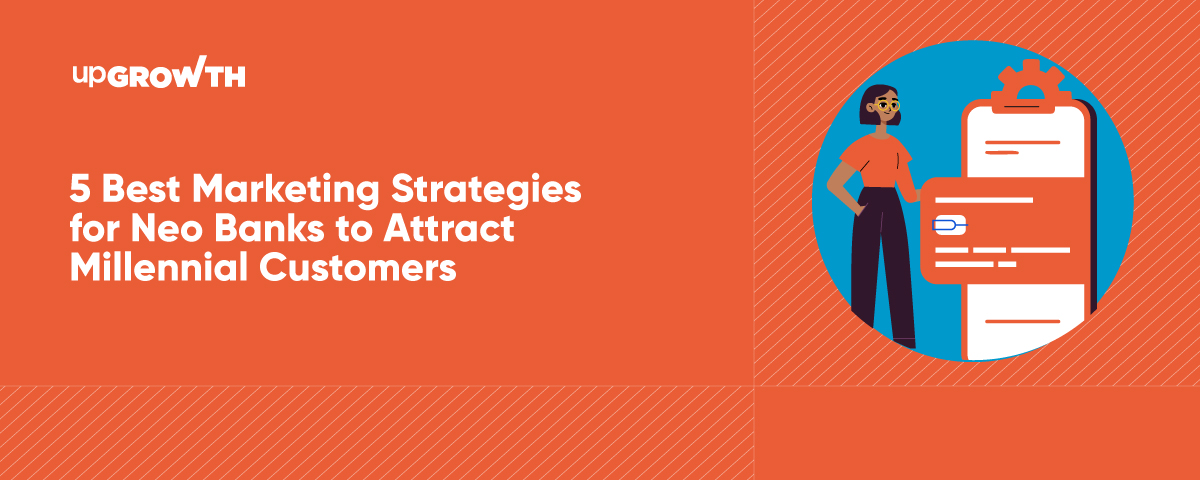5 Best Marketing Strategies for Neo Banks to Attract Millennial Customers
Contributors:
Abid Ali
Published: December 6, 2024

Summary
Neo banks must cater to millennials by offering tailored financial products, seamless digital banking, and value-driven services. This guide outlines actionable strategies, such as leveraging social media, adopting eco-conscious practices, and gamifying financial experiences, to build trust and drive engagement with the millennial demographic.
The competition in the neobanking market is fierce, with traditional banks rapidly adapting to digital innovation and new players entering the ecosystem. For neo banks, standing out from the crowd means understanding your most important demographic—millennials.
This generation, born roughly between 1981 and 1996, is digital-savvy, values transparency, and demands personalized experiences. With millennials becoming the most considerable financial demographic globally, their expectations are reshaping the financial industry.
Understanding the Neo Banking Market and Millennials’ Persona
What Are Neo Banks?
Neo banks are digital-first financial institutions that offer services through apps or platforms instead of traditional brick-and-mortar branches. These banks aim to provide streamlined and mobile-friendly banking experiences, lower fees, and innovative financial solutions.
Millennials as the Core Demographic
Millennials dominate the digital payment ecosystem. According to a study by Financial Brand, 98% of millennials use mobile banking apps, and they prioritize convenience, transparency, and intuitive design. Unlike previous generations, millennials are less loyal to traditional financial institutions, preferring agile digital-first solutions instead.
The Landscape of Neobank Competition
With over 400 neobanks globally, including players like Chime (US), Revolut (UK), and N26 (Europe), the market is exponentially growing. However, traditional banks are also adapting, creating stiffer competition for customer acquisition. Neo banks must take innovative approaches to stand out and build trust with this highly influential demographic.
Top 5 Marketing Strategies for Neo Banks to Attract Millennial Customers
1. Leverage Digital-First Experiences to Build Trust
Seamless Digital Banking is Essential:
Millennials demand convenience. A study by Statista revealed that 73% of millennials expect banks to provide services through well-designed and reliable mobile apps. For neo banks, a smooth digital experience isn’t just a feature—it’s the expectation.
Features Millennials Value Most in Digital Banking:
- Intuitive User Interfaces with simple navigation
- Real-time notifications for spending and balance updates
- Innovative Tools for budgeting, savings, and in-app financial advice
- 24/7 Chat Support to provide instant customer care
Real-Life Example of Success :
Consider Chime’s success in the U.S. Its app-centric approach prioritizes user experience, offering features like fee-free overdrafts and real-time notifications. By addressing millennial pain points, Chime has grown into one of the most trusted neobanks.
Pro Tip:
Invest in usability testing and conduct regular feedback sessions from millennials to continuously refine your app design.
2. Personalization is the Key to Capturing Millennial Loyalty
The Power of Personalization:
Millennials don’t want to feel like one of many customers—they want tailored services. According to Accenture, 91% of millennials prefer brands that offer personalized product recommendations and services.
How Neo Banks Can Personalize?
- Customized Financial Products – Offer tailored loans or savings accounts based on spending habits.
- Dynamic Rewards Programs – Provide personalized cashback or rewards that suit the customer’s lifestyle (e.g., discounts at eco-friendly stores).
- Content Personalization – Send helpful notifications or reminders, such as personalized savings tips.
Data-Driven Personalization:
By leveraging customer data and advanced AI tools, neo banks can deliver hyper-personalized marketing campaigns that not only attract but also retain millennial customers.
Case Study:
European Neobank N26 uses data analytics to send tailored financial advice to users, such as highlighting monthly subscription costs or recurring payments they may want to cancel. This personalization enhances customer experience and strengthens engagement.
3. Social Media & Influencer Marketing are Crucial for Millennial Engagement
Millennials spend an average of 2.5 to 3 hours daily on social media, making it a vital channel for neo banks to connect with their audience.
Where to Reach Millennials?
- Instagram – Perfect for lifestyle-driven and visual branding.
- Twitter – Valuable for quick updates, finance tips, and customer engagement.
Best Practices for Social Media Marketing:
- Create content that educates, entertains, and inspires confidence in your platform.
- Include interactive content like polls, AMAs (Ask Me Anything), and success stories.
- Highlight user testimonials to build credibility.
Influencer Collaborations:
Partnering with financial influencers or lifestyle/content creators resonates deeply with millennial audiences. Influencers can showcase app features, share their banking experiences, and drive massive brand awareness for neo-banks.
Example:
Revolut ran a successful campaign with renowned influencers who demonstrated how the app could simplify international travel budgeting. This led to significant brand visibility on social platforms.
4. Eco-Conscious & Value-Driven Marketing
Align with Millennial Values:
Millennials are profoundly value-driven, with 73% willing to pay more for sustainable products. Neo banks that emphasize corporate social responsibility (CSR) can differentiate themselves significantly.
Strategies to Attract Eco-Conscious Consumers:
- Introduce Green Financial Products, such as accounts that plant trees for every transaction.
- Use Transparent Reporting to show sustainable practices, such as investments in ethical funds.
- Partner with environmental initiatives or nonprofits to support more prominent global causes.
Example:
Aspiration Bank in the U.S. markets itself as an “eco-conscious” bank, offering an account that plants trees based on card usage. Its transparency and alignment with environmental values have made it a favourite among millennial customers.
5. Gamification & Rewards Programs to Drive Engagement
Millennial Gamification Trends:
Gamification isn’t just for entertainment anymore—it’s also a tool for engaging millennials. Neo banks that incorporate gamified mechanics into their apps see higher user interaction and retention rates.
Gamification Strategies:
- Provide in-app challenges, such as savings goals with visual progress tracking.
- Reward users with points, cashback, or discounts when spending responsibly.
- Use leaderboards or milestones to encourage friendly competition among users.
Benefits of Gamification:
A study by Finextra found that incorporating gamification increases app engagement by 40% and strengthens brand loyalty, especially among younger users.
Example:
Monzo’s feature for dividing savings into “pots” with gamified progress bars encourages users to reach their financial objectives in a fun and engaging way.
Building the Future of Neo Banks with Millennials
The financial industry is undergoing a transformational evolution, and millennials are driving the demand for agile, customer-centric solutions. To succeed in this competitive market, neo-banks must double down on digital-first experiences, personalization, and engagement tactics like social media and gamification, all while aligning with millennial values.
At upGrowth, we specialize in helping fintech companies and neo banks optimize their strategies to attract and retain customers. From creating millennial-focused campaigns to driving data-driven growth, our team enables you to craft a roadmap to success.
Partner with us to revolutionize your customer acquisition and retention strategy. Contact upGrowth today!
FAQs
1. How to Attract Millennial Customers?
To attract millennial customers, neo banks must leverage digital-first strategies that focus on convenience, personalization, and value alignment. This includes offering intuitive app interfaces, hyper-personalized financial tools, sustainable practices, and engaging social media campaigns to connect with this tech-savvy generation.
2. What Specific Attributes of Neobanks Appeal Most to Millennial Customers?
Millennials appreciate neo-banks for their user-friendly interfaces, 24/7 accessibility, quick onboarding processes, and fee transparency. Features like instant payments, budgeting tools, and eco-conscious financial products also resonate well with this demographic.
3. How Can Neobanks Utilize Social Media Effectively to Engage with the Millennial Demographic?
Neo banks can successfully engage millennials on social media by creating educational and entertaining content, partnering with influencers, and leveraging interactive posts like polls and Q&A sessions. Platforms such as Instagram and TikTok are optimal for showcasing features creatively, while micro-interactions on Twitter build trust and rapport.
4. What Are the Key Differences in Marketing Tactics Between Neobanks and Traditional Banks When Targeting Millennials?
Neobanks focus on digital marketing, personalization, and real-time engagement. In contrast, traditional banks often rely on legacy systems and broader branding strategies. Neo banks use gamification, social responsibility, and influencer collaborations to build trust with millennials. In contrast, traditional banks still heavily depend on physical branches and conventional advertising.
5. How Does Neobanks Measure the Success of Their Marketing Strategies Aimed at Millennials?
Neobanks track KPIs such as customer acquisition cost (CAC), user engagement rates, app downloads, and retention metrics. They also measure the effectiveness of campaigns through data analytics, social media reach, and user feedback to continuously refine strategies.
6. What Role Does Technology Play in Crafting Marketing Strategies That Resonate with Millennials?
Technology is at the heart of neo-bank marketing strategies. Data analytics creates hyper-personalized campaigns, AI chatbots offer 24/7 support, and app features such as push notifications keep users engaged. Additionally, technology enables seamless integration with social media platforms for robust, real-time engagement.
7. How Important Is Personalization in Marketing Efforts to Attract Millennial Neobank Users?
Personalization is crucial for attracting millennials. Tailoring financial recommendations, offering spending insights, and customizing in-app experiences demonstrate an understanding of individual user needs, building stronger trust and loyalty to the brand.
About the Author
Copywriter
Abid Ali is an Associate Copywriter at upGrowth, where he plays a key role in supporting diverse marketing projects with his knack for creating engaging and persuasive content. With a sharp eye for detail and a passion for storytelling, Abid collaborates closely with the team to bring innovative ideas to life, ensuring every campaign resonates with its audience. His dedication to crafting impactful messaging reflects his growth-oriented mindset and commitment to excellence.
 Growth Strategy and Planning
Growth Strategy and Planning Inbound Growth
Inbound Growth Growth Hacking
Growth Hacking Search Engine Optimization
Search Engine Optimization Paid and Performance Marketing
Paid and Performance Marketing Social Media Marketing
Social Media Marketing AI-Driven Growth Strategy
AI-Driven Growth Strategy
 Growth Tools
Growth Tools Offers
Offers

















Leave a Reply